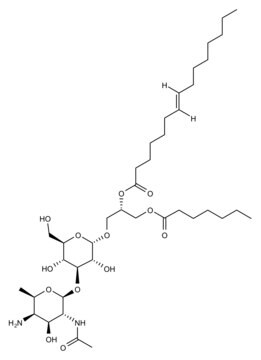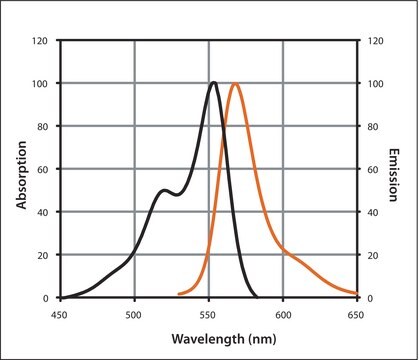추천 제품
생물학적 소스
Staphylococcus aureus
Quality Level
형태
lyophilized powder
작용기
phospholipid
지질 유형
polymerizable lipids
배송 상태
ambient
저장 온도
2-8°C
관련 카테고리
일반 설명
Lipoteichoic acid (LTA) is a linear polymer of phosphodiester-linked glycerol phosphate covalently bound to a lipid. The C2 position on the glycerol-phosphate is usually glycosylated or D-alanylated. LTA is amphipathic due to the presence of the negatively charged backbone of glycerol phosphate and the hydrophobic lipid. The lipid portion is bound hydrophobically to the cell membrane, whereas the polyglycerol phosphate portion extends into the cell wall.
Lipoteichoic acid (LTA) is a teichoic acid attached to a lipid abundant on Gram-positive bacteria cell wall. LTA is a pathogen-associated molecular-patterns (PAMP) recognized by Toll-like receptor 2 (TLR2), This recognition leads to the activation of NF-kB.
애플리케이션
Lipoteichoic acid from Staphylococcus aureus has been used:
- to investigate the binding properties of SpHyastatin to lipopolysaccharides and lipoteichoic acid using enzyme-linked immunosorbent assay (ELISA)
- to measure the interleukin (IL-6) produced in splenocytes using a sandwich ELISA
- as a toll-like receptor 2/6 (TLR2/6) agonist to explore its potential to induce tumoricidal M1 macrophage phenotype
생화학적/생리학적 작용
Lipoteichoic acid (LTA) is a complex component of cell walls of Gram-positive bacteria that are involved in a wide range of cell processes such as the stimulation of immune responses and cell signaling pathways. LTA differs between species of gram-positive bacteria. Lipoteichoic acid from Streptococcus aureus may be used to compare its structure, immunogenicity and functions versus other bacterial LTAs.
Lipoteichoic acid (LTA) is a complex component of the cell walls of Gram-positive bacteria that are implicated in a wide range of cellular processes such as the stimulation of immune responses and cell signaling pathways. LTA differs between species of Gram-positive bacteria. Lipoteichoic acid from Streptococcus aureus may be used to compare its structure, immunogenicity, and functions versus other bacterial LTAs.
관련 제품
제품 번호
설명
가격
Storage Class Code
11 - Combustible Solids
WGK
WGK 3
Flash Point (°F)
Not applicable
Flash Point (°C)
Not applicable
개인 보호 장비
Eyeshields, Gloves, type N95 (US)
시험 성적서(COA)
제품의 로트/배치 번호를 입력하여 시험 성적서(COA)을 검색하십시오. 로트 및 배치 번호는 제품 라벨에 있는 ‘로트’ 또는 ‘배치’라는 용어 뒤에서 찾을 수 있습니다.
이미 열람한 고객
Simin Rezania et al.
Cancer cell international, 14, 54-54 (2014-06-27)
Many types of tumors are organized in a hierarchy of heterogeneous cell populations with different molecular signature. Such heterogeneity may be associated with different responsiveness to microenvironment stimuli. In the present study, the effects of lipopolysaccharide (LPS) and lipoteichoic acid
S Morath et al.
The Journal of experimental medicine, 193(3), 393-397 (2001-02-07)
Lipoteichoic acids (LTAs) have been proposed as putative Gram-positive immunostimulatory counterparts to Gram-negative lipopolysaccharides. However, LTA from Staphylococcus aureus, the clinically most frequent Gram-positive pathogen, was inactive after purification. Here, a novel isolation procedure to prepare pure (>99%) biologically active
Varenka J Barbero-Becerra et al.
World journal of gastroenterology, 17(10), 1317-1325 (2011-04-02)
To study the role of gram-positive and gram-negative bacteria in the pathogenesis of liver injury, specifically the activation of inflammatory mediators. Peripheral blood mononuclear cells of 20 out-patients were studied, 10 of them with cirrhosis. Peripheral blood mononuclear cells were
Nien-Tzu Chou et al.
Evidence-based complementary and alternative medicine : eCAM, 2012, 735396-735396 (2013-01-11)
Chlorella sorokiniana (CS) is a unicellular green alga. The extracts of Chlorella have been used as treatments for relieving hypertension and modulating immune response. The detailed mechanisms are not clear yet. In this study, we sought to study the molecular
Gopinath Kasetty et al.
Antimicrobial agents and chemotherapy, 55(6), 2880-2890 (2011-03-16)
Peptides of the C-terminal region of human thrombin are released upon proteolysis and identified in human wounds. In this study, we wanted to investigate minimal determinants, as well as structural features, governing the antimicrobial and immunomodulating activity of this peptide
자사의 과학자팀은 생명 과학, 재료 과학, 화학 합성, 크로마토그래피, 분석 및 기타 많은 영역을 포함한 모든 과학 분야에 경험이 있습니다..
고객지원팀으로 연락바랍니다.









